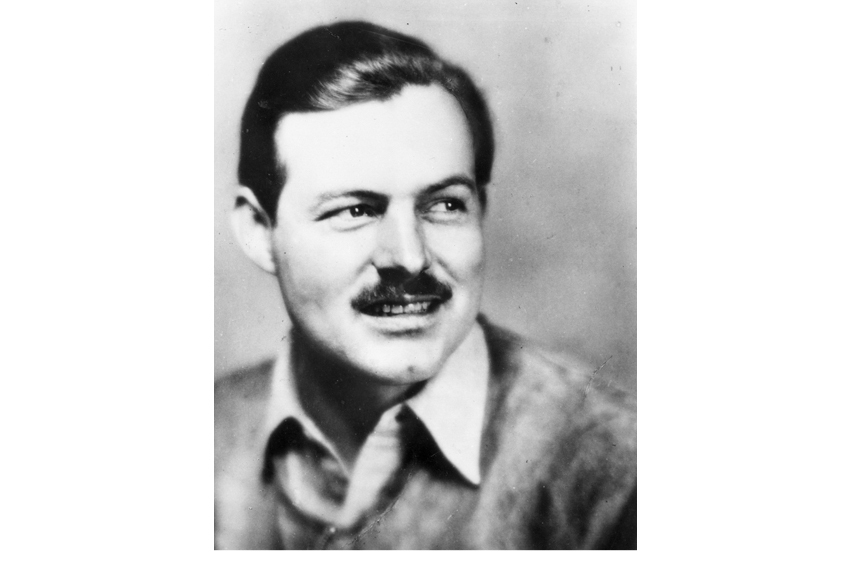There was a time when every alpha-male tyro author had to read Hemingway. He was an amalgam of Stephen Crane, François Mauriac and Errol Flynn, roistering war reporter, existential swaggerer and sexual aggressor, and a superb prose stylist to boot. When in 1978 Bruce Chatwin identified the literary masters whom an aspirant novelist should emulate, he recommended Chekhov, Maupassant, Flaubert and Turgenev for their piercing concision and stylistic richness, ‘and among the Americans, early Sherwood Anderson, early Hemingway and Carson McCullers’.
It is a good list for non-fiction writers as well as novelists. The Sun Also Rises (1926) and A Farewell to Arms (1929) — both drawing on experiences that are covered in this volume of Hemingway’s early letters — are great novels from which writers can learn. There is vaunting ambition in his later books, even if they sometimes seem overstrained. He deserved his Nobel Prize despite the stylistic tics. He did not deserve, despite the drunken posturing with which he tried to mask the depressive anxieties that caused his suicide, Truman Capote’s jibe that he was ‘the closet everything’.
Although Hemingway’s place in the 20th-century American canon is assured, he is uncherished today. It is partly to revive sympathy for him that a project has been launched to publish all his surviving letters, and thus reveal the mainsprings of his ideas and actions to a new generation. This volume has two editors, three associate editors, an advisory editor, and a project editor to keep one another from slacking. The result is a work of monumental authority, shrewd and sympathetic, which will be indispensable for anyone delving into Hemingway’s childhood affections, adolescent bravura, and the hope, enthusiasm and disgust of his early manhood.
In the period covered by these letters Hemingway was a dutiful child (a physician’s son growing up in a comfy Chicago suburb), a cub reporter on the Kansas City Star, a volunteer Red Cross ambulance driver on the Italian front, a foreign correspondent based in Paris, and ace reporter covering the Greco-Turkish war. The overall effect is a hotchpotch.
There are great letters in this collection. As a Red Cross canteen worker in Italy Hemingway took the foolhardy course of bicycling to the trenches every day laden with chocolate and tobacco for distribution to the troops. On the seventh of these trips he was injured by a trench mortar shell exploding near him. His subsequent letters from hospital to his family are heart-stopping. With what pride, anguish and love they were read by his parents one can only guess. They constitute the book’s highpoint.
There are also stirring letters about his love-life. He became engaged in Italy to a feisty nurse, who jilted him in the hope of marrying the heir to a dukedom — only to be jettisoned in turn. He then courted and married Hadley Richardson. These amorous advances and rebuffs are recounted in attitudinising letters by a young man testing how intense he can convincingly sound. They make passionate reading, especially for emotional voyeurs.
For lovers of American literature there is interest in Hemingway’s meetings with Sherwood Anderson, whose newly published Winesburg, Ohio was raising a storm. Anderson gave him letters of introduction when he went to Paris as the correspondent of a Toronto newspaper, though it is questionable whether he appreciated Hemingway’s piece that was headlined ‘American Bohemians in Paris a Weird Lot.’
Hemingway, explains the general editor Sandra Spanier in an introduction of graceful lucidity, was a prolific letter-writer because he was eager to receive letters back. This is the mark of many inveterate correspondents, from Horace Walpole onwards. Unfortunately in many letters Hemingway indulged in hectic ventriloquism. It is not too bad when the voice is Kipling’s blokey vernacular — sometimes with direct quotations. But often the verbal vaudeville and facetious jumble are reminiscent of the boring provincial humour that Sinclair Lewis skewered in Babbitt.
As one example, here is the opening to a letter to a Missouri-born friend whom
Hemingway had met in Kansas City: Ha Ha! Ha! Ha! Ha! Ha! Tis none other than the greatest of the Hemingsteins that indicts this epistle. Woodrow, me lad, comma how are you. Much obliged for your sending ye old Liberty Bond. In the words of Smith ye beamer it was most good of you. And the great Hicks. He of the tortoise shelled disposition and the sad lack of anal covering.
Alas, too, Hemingway’s boasts about drinking binges are as squalid as they would be from a Middlesbrough chav on a Saturday night in 2011, and sad in a man of his gifts.
The Letters of Ernest Hemingway will not be widely read. But they give a sense that behind the facetious bluster there was an abyss of inexplicable, unnameable panic. Hemingway, one concludes, was a writer of taut personal discipline, ruthless in what he demanded of himself, for whom work was the only thing that made life tolerable.






Comments